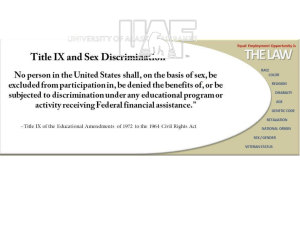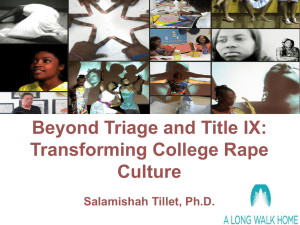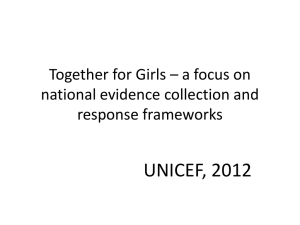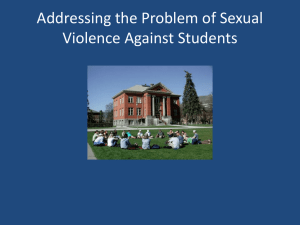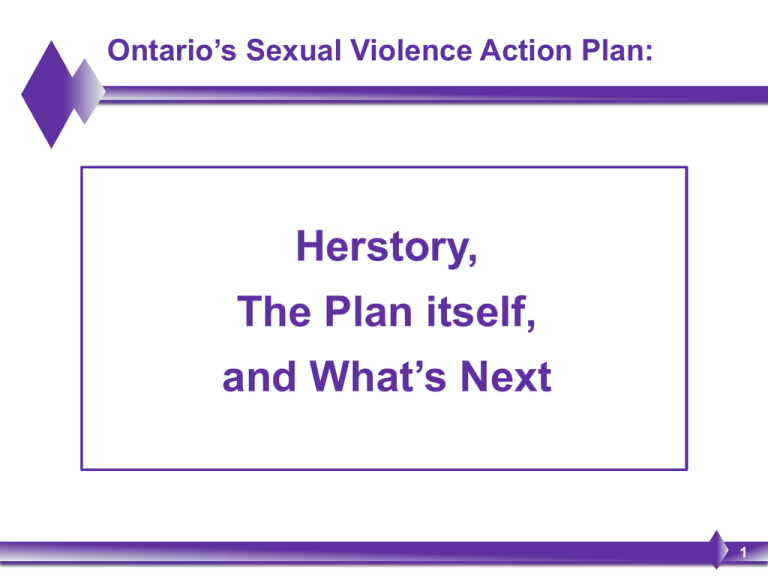
Ontario’s Sexual Violence Action Plan:
Herstory,
The Plan itself,
and What’s Next
1
Where Did We Begin?
The concept of a sexual violence action plan first made it on the government’s
agenda 8 years ago. OCRCC and its allies knew that this was the time to start
advocating for a Plan as the polls were showing that the Harris (Conservative)
provincial government was not in favour of being re-elected.
OCRCC met with Dalton McGuinty and other politicians to get them to sign
onto a plan of action to help get the initiative in motion. The Liberals agreed.
The Ontario Women’s Directorate (OWD) supported a strategy, and
working directly with OCRCC. The plan began by putting together a working
definition of sexual violence
Unfortunately, Ministers changed often and OCRCC frequently saw the same
preliminary meetings over and over again with different representatives.
2
Our Message
1. “Listen to survivors of sexual violence and women’s advocates.”
2. “Acknowledge that different women experience sexual violence −
and are targeted for acts of sexual violence − differently.”
3. “Create an Action Plan that envisions an Ontario where all women
are safe from all forms of sexual violence and the threat of sexual
violence in their homes, workplaces, places of education, and in
their communities.”
3
Developing Ontario’s Sexual Violence Action Plan
In 2010, OCRCC also took part in many aspects of the development of the
Ontario Sexual Violence Action Plan. These included:
Contributing to the development of the SVAP vision and principles (May 6)
Consulting with OWD staff at several planning meetings (various dates)
Participated in a pre-consultation meeting with provincial VAW stakeholders (May 10)
Hosting a consultation with OCRCC membership (June 24)
Participating in several stakeholder consultations over the summer of 2010
Participating in a consultation session on Campus Safety (June 29)
Participating in a consultation session on Public Education High School (June 29
Participating in a consultation session on Training Needs for Professionals (Sept 2)
Participating in a consultation session on Trafficking (Sept 8)
4
Developing Ontario’s Sexual Violence Action Plan
In 2010, in partnership with the Ontario Women’s Directorate, OCRCC consulted
with survivors of sexual violence for the purpose of informing the Ontario Sexual
Violence Action Plan.
Survivors of sexual violence attended consultation meetings in:
Guelph
Peel
Toronto
Ottawa
Sudbury
Kenora
Sarnia
The survivor consultations were integral to a survivor-focused and informed
Action Plan.
5
What Survivors told us
“[The] court expects women to be being weak and silent…I was humiliated in the
court for having emotions related to [my] sexual violence experiences.”
Guelph, Ontario survivor
Survivor Consultation, 2011
“There are also many suicide attempts after rape, I know of three women right
now that have tried to commit suicide several times and the men are free…We’re
back in the 1950’s, [where] it’s all about the woman’s fault, you wanted it, look
what you’re wearing.”
Kenora, Ontario survivor
Survivor Consultation, 2011
“The police are there to serve and protect − [but] if they do not believe you and
they do not do anything, what is going to happen? I am not going to tell because
no one will believe me − which is why women suffer in silence.”
Guelph, Ontario survivor
Survivor Consultation, 2011
6
What Survivors told us cont.
“Recogniz[e] the cultural experiences of abuse and trauma (eg. aboriginal
women).”
Guelph, Ontario survivor
Survivor Consultation, 2011
“[The] Police officer said ‘oh well these things happen in your community’.”
Peel, Ontario survivor
Survivor Consultation, 2011
“The level of vulnerability of those with disabilities needs to be considered in the
planning so there is more support” [for these women].
Guelph, Ontario survivor
Survivor Consultation, 2011
“Racism is rampant. First Nations people are dying in the jail system, police,
corrections officers, members of judicial system need cultural sensitivity training.”
Kenora, Ontario survivor
Survivor Consultation, 2011
7
Ontario’s Sexual Violence Action Plan:
The Ontario Women’s Directorate announced the Sexual Violence Action
Plan in March of 2011. It is currently a 4-year Plan. It includes:
Funds to develop and implement public education campaigns
Funds for sexual assault centres, and increased funds for outreach
strategies in Northern regions
Funds for resources for campus sexual assault prevention
Refine current standards concerning how Sexual Assault/Domestic
Violence Treatment Centres respond to drug-facilitated sexual assault
Refine current standards concerning how Sexual Assault/Domestic
Violence Treatment Centres respond to women with disabilities
8
Ontario’s Sexual Violence Action Plan:
It also includes:
Funds to support OCRCC and Action Ontarienne to develop and deliver
training for staffs concerning supporting women with addictions, mental
health diagnosis and trauma
Increased support to Francophone communities
Address sexual violence against Aboriginal women
Invest funds to expand the Language Interpreter Services program to
women who have experienced sexual assault and human trafficking
Funds to launch a number of anti-human trafficking initiatives
Establish a human trafficking advisory committee, which will include
survivors
9
Strengths
It recognizes different types of sexual violence, including exploitation,
human trafficking, sexual harassment, sexual assault and exploitation
via the internet/other technologies
It recognizes the work of Sexual Assault Centres and women’s
advocates, and the long history of grassroots anti-violence work
Identifies sexual violence as a gender-based crime
Describes the consultations process, and who participated
Identifies some common sexual assault myths, victim-blaming rhetoric
surrounding sexual assault, and the impact this has on survivors
10
Weaknesses
It does not acknowledge that sexual assault myths are a direct result of
sexual violence being a crime rooted in sexism, racism, classism, and
other reflections of social inequalities
It does not recognize that different women will experience different
myths, or differing system responses, due to their presenting social
location
While SVAP does identify that sexual assault myths discourage or
prevent women from reporting, it does not recognize how these myths
and woman-blaming rhetoric are reflected in reporting processes, the
criminal justice system, and sentences for offenders
Women’s hesitations to report/seek help is phrased more as “women’s
fears” than it is in the actual validity of these fears (and we know their
fears are valid)
11
Ontario’s Sexual Violence Action Plan:
We recommend…
The critical examination of the systems and institutions
Recognize the skills and knowledge that women, diverse women, and
survivors of violence bring to the work; and recognition that different women
experience violence differently
Approaches that do NOT focus on restricting women’s movements or activities
Prevention and response strategies that do NOT focus solely on police
reporting/criminal justice response to sexual assault and domestic violence
Frame sexual violence as a social problem, as opposed to a mental health
malfunction that the survivor must be cured of
Liaising with other groups, survivors and demographics that can share their
expertise on sexual violence, and help to implement the plan
Something way bigger than a 4-year Plan
12
Ontario’s Sexual Violence Action Plan
Questions?
13



